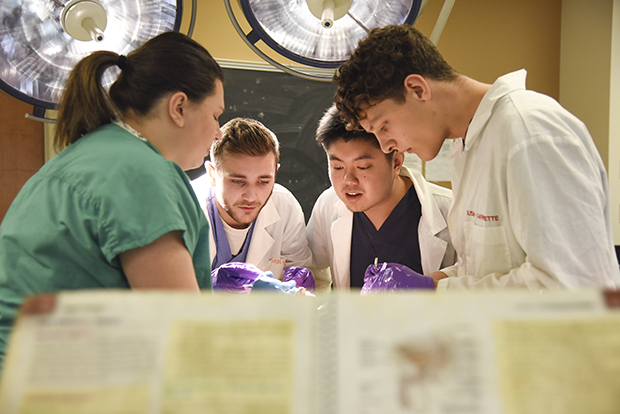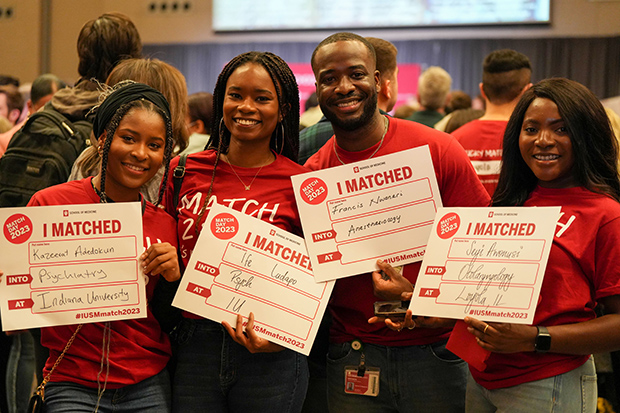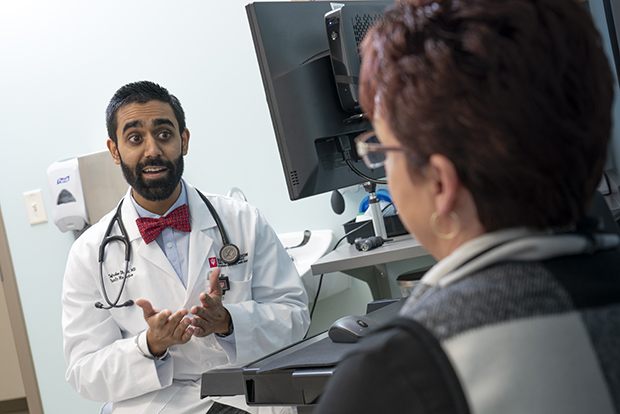Steady growth made IU School of Medicine the nation’s largest medical school, but an overhauled curriculum, metric-driven decisions, expanded student services, and new residency programs aim to make it among the best.
THE FIRST TIME Dean Hess met Paul Wallach, MD, the circumstances weren’t ideal.
In early 2017, IU School of Medicine was gearing up for a stressful rite: reaccreditation. To have it renewed, the school would host a visit by officials from the Liaison Committee on Medical Education. To prepare, the school staged dry runs.
“We were struggling,” Hess said.
They were the latest in a series of growing pains Hess encountered early in his tenure. Previously, IU had scaled up enrollment by 30 percent to address a looming physician shortage in Indiana. Doing so meant increasing head counts at eight regional campuses and shifting them from teaching two years of basic science to a full four-year curriculum.
Under LCME guidelines, a medical school requires a uniform curriculum which must be deployed in a comparable way at schools with regional campuses—the opposite of IU’s system at the time. From their inception, most regional campuses operated with considerable independence. When the school adopted a new common curriculum, faculty who had long taught courses they created now used materials prepared by others and taught as part of a team.
“There was a small number of people who just couldn’t go along with it,” Hess recalled.
Meanwhile, the school had to sway potentially skeptical LCME officials that the school’s education was comparable across its nine campuses. Hess hired consultants. The process included a simulated or “mock” site visit. One member of the trio was Wallach, then-vice dean of academic affairs at the Medical College of Georgia.
Over several days, Wallach made a lasting impression on Hess. After the school’s credentials were renewed, Hess wooed him to Indianapolis. “It was clear to me Paul had this incredible knowledge base,” Hess said. “I worked to get Paul here so we would have someone of that caliber.”

Medical students work together during an anatomy lab at IU School of Medicine—West Lafayette, one of eight regional campuses that collectively saw enrollment jump by 40 percent in the past 10 years.
NOW, THOSE EARLY strains have proven to be worth the effort.
With more than 1,400 students (approximately 40 percent are based at regional campuses) IU remains the nation’s largest medical school. Each regional campus has carved out a distinct niche. Three of them have relocated to newly constructed facilities. And the school has made marked improvements in preparing graduates to excel once they leave IU behind and begin residency.
From his sixth-floor office at Fairbanks Hall, Wallach recalled the ambition he and Hess share. “When I was being recruited, we spoke about the development of a preeminent medical education program,” said Wallach, executive associate dean for educational affairs. “This was a place that could become absolutely spectacular.”
By the time Wallach arrived in 2018, enrollment was cresting, and the new curriculum had been rolled out. His task was to do more than keep it all humming. “It’s the biggest sandbox to play in,” he said.
The new curriculum streamlines a student’s first two years, shaving off several months and getting students to clerkships earlier. A series of brief courses were created to manage the three critical transitions in medical school: getting started, moving to the clinical years, getting ready to be a resident. Short intercessions impart skills in behavioral health, communications, and ethics.
By their fourth year, IU students focus on professional development, career exploration, and residency preparation. Outside of three advanced clerkships (emergency medicine, sub-internship, critical care), they load up on electives like bench research, and rotate among subspecialties across the state.
Along the way, faculty offered input that helped tweak the structure in ways that better prepare students and assess readiness. The context and environment in which education is delivered is important. The student affairs office helps create that positive environment and has expanded services to support student success.
The school also launched 17 scholarly concentrations across the state, drawing on each campus’s faculty, expertise, and character. The programs involve electives, a research project, and targeted mentoring. Unlike traditional certificates, there’s no added time or cost. Most students can complete the entire concentration prior to graduation.
“The concentrations allow a student to focus their education on topics such as health disparities and urban health care, rural health, biomedical engineering, or the business of health care. They also enable campuses to claim an area of excellence,” Wallach said.

The success of students matching into residency programs is a crucial indicator for school officials. In 2023, 99.7 percent of fourth-year students secured a slot.
ALMOST EVERY OBJECTIVE metric shows the plan is working.
Students scored above the national average on all exams given at the end of their clerkships. This spring, the Class of 2023 had a match rate of 99.7 percent, sending graduates to New York University, Johns Hopkins, Stanford, and Yale, to name a few. A survey of residency program directors found that almost 98 percent reported IU graduates were equal to or above the expected competency level.
To Wallach, it reflects that the school is upholding its duty.
“We don’t just teach medical knowledge for the sake of it,” he said. “The people who graduate from these programs are entrusted to care for me, you, our families, and our communities. There’s a sacred trust involved in educating doctors. It’s critical that our graduates are extremely capable.”
To make it easier for Hoosiers to access care, there’s not only a need to graduate more doctors but also to create more residency slots in Indiana. In the last five years, the School of Medicine has expanded residency slots at IU Health Arnett in Lafayette and partnered with four hospital systems to launch primary residencies in Evansville.



